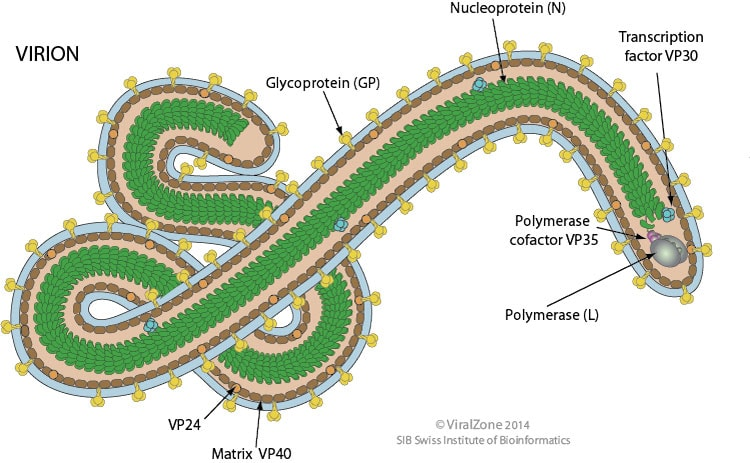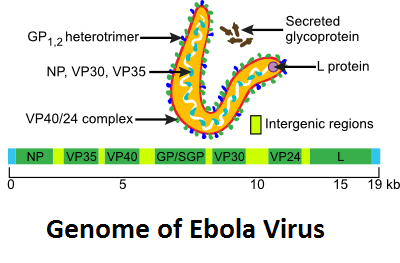

Ebola Virus
Ebola virus belongs to the Filoviridae family. The name is derived from the Latin word "filum" meaning thread. The filamentous virus has a characteristic twisted thread shape. Filoviridae viruses are negative-strand RNA viruses. They are the most common to infect humans and primates, causing highly fatal hemorrhagic fever.
Ebola Virus are generally approximately 80 nm in diameter, 970 nm long.
They contain viral envelope, matrix, and nucleocapsid components. The virus generally appears in a long, filamentous form, but it can also be “U-shaped,” in the shape of a “6” (the “shepherd’s crook” appearance), or even circular.
Ebola Virus have a negative-sense, non-segmented single stranded linear RNA genome about 18-19 kb in size. It encodes seven structural proteins: nucleoprotein (NP), polymerase cofactor (VP35), (VP40), GP, transcription activator (VP30), VP24, and RNA polymerase (L).
Nucleoprotein(P18272)
Function:
Oligomerizes into helical capsid to encapsidate the viral genome, protecting it from nucleases and the cellular innate immune response (PubMed:26119732, PubMed:25865894, PubMed:30333622, PubMed:16719918).
VP35 binds to and stabilizes monomeric NP, keeping it soluble (PubMed:26119732, PubMed:25865894).
Upon virus replication, NP is recruited to bind cooperatively viral genomic RNA and VP35 is released (PubMed:29144446).
The encapsidated genomic RNA is termed the nucleocapsid and serves as template for transcription and replication. The nucleocapsid is helical with a pitch of 10.81 NP per turn and a diameter of about 22nm (PubMed:22247782).
Each NP binds to six nucleotides of viral genomic RNA, three being exposed to the solvant and three hidden into the nucleocapsid (PubMed:30333622).
Recruits also host PPP2R5C phosphatase to dephosphorylate VP30 and thereby promote viral transcription (PubMed:29290611, PubMed:27755595).
Upon virion assembly and budding, NP binds to VP24 and possibly host STAU1 (PubMed:28794491, PubMed:30301857).
Polymerase cofactor VP35 (Q05127)
Function
Plays an essential role in viral RNA synthesis and also a role in suppressing innate immune signaling (PubMed:11027311).
Acts as a polymerase cofactor in the RNA polymerase transcription and replication complexes (PubMed:9971816, PubMed:16495261, PubMed:24495995).
Serves as nucleoprotein/NP monomer chaperone prior to the formation of the large oligomeric RNA-bound complexes (By similarity).
Regulates RNA synthesis by modulating NP-RNA interactions and interacting with DYNLL1 (PubMed:25741013).
VP35-NP interaction controls the switch between RNA-bound NP and free NP and thus the switch between genome replication and genome packaging into the nucleocapsid (PubMed:25865894).
Prevents establishment of cellular antiviral state, thereby suppressing host DC maturation (PubMed:26962215).
Acts by inhibiting host DDX58/RIG-I activation both by shielding dsRNA from detection and by preventing PRKRA binding to DDX58 (PubMed:23870315).
Blocks virus-induced phosphorylation and activation of interferon regulatory factor 3/IRF3, a transcription factor critical for the induction of interferons alpha and beta (PubMed:12829834). This blockage is produced through the interaction with and inhibition of host IKBKE and TBK1, producing a strong inhibition of the phosphorylation and activation of IRF3 (PubMed:12829834).
Also inhibits the antiviral effect mediated by the host interferon-induced, double-stranded RNA-activated protein kinase EIF2AK2/PKR (PubMed:17065211).
Increases PIAS1-mediated SUMOylation of IRF7, thereby repressing interferon transcription (PubMed:19557165).
Also acts as a suppressor of RNA silencing by interacting with host DICER1, TARBP2/TRBP and PRKRA/PACT (By similarity).
As a dimer, binds and sequesters dsRNA contributing to the inhibition of interferon production (By similarity).
Matrix protein VP40 (Q05128)
Function
Plays an essential role virus particle assembly and budding (PubMed:16719918, PubMed:33673144).
Acts by interacting with viral ribonucleocapsid and host members of the ESCRT (endosomal sorting complex required for transport) system such as host VPS4, PDCD6IP/ALIX, NEDD4 or TGS101 (PubMed:15892969, PubMed:16719918, PubMed:23637409, PubMed:25786915, PubMed:26753796, PubMed:27489272).
The interaction with host E3 ubiquitin ligase SMURF2 also facilitates virus budding (PubMed:33673144).
May play a role in immune cell dysfunction by being packaged into exosomes that can decrease the viability of recipient cells (via RNAi suppression and exosome-bystander apoptosis) (PubMed:27872619).
Envelope glycoprotein (Q05320)
Function
Envelope glycoprotein:
Trimeric GP1,2 complexes form the virion surface spikes and mediate the viral entry processes, with GP1 acting as the receptor-binding subunit and GP2 as the membrane fusion subunit. At later times of infection, downregulates the expression of various host cell surface molecules that are essential for immune surveillance and cell adhesion (PubMed:11836430).
Down-modulates several integrins including ITGA1, ITGA2, ITGA3, ITGA4, ITGA5, ITGA6, ITGAV and ITGB1 (PubMed:11112476).
This decrease in cell adhesion molecules may lead to cell detachment, contributing to the disruption of blood vessel integrity and hemorrhages developed during infection (cytotoxicity) (Probable). Interacts with host TLR4 and thereby stimulates the differentiation and activation of monocytes leading to bystander death of T-lymphocytes (PubMed:28542576).
Downregulates as well the function of host natural killer cells (PubMed:30013549).
Counteracts the antiviral effect of host BST2/tetherin that restricts release of progeny virions from infected cells (PubMed:26516900, PubMed:27707924, PubMed:29669839).
However, cooperates with VP40 and host BST2 to activate canonical NF-kappa-B pathway in a manner dependent on neddylation (PubMed:28878074).
Shed GP:
Functions as a decoy for anti-GP1,2 antibodies thereby contributing to viral immune evasion. Interacts and activates host macrophages and dendritic cells inducing up-regulation of cytokine transcription. This effect is mediated through activation of host TLR4.
GP1:
Responsible for binding to the receptor(s) on target cells. Interacts with CD209/DC-SIGN and CLEC4M/DC-SIGNR which act as cofactors for virus entry into dendritic cells (DCs) and endothelial cells (PubMed:16051836).
Binding to the macrophage specific lectin CLEC10A also seems to enhance virus infectivity (By similarity).
Interaction with FOLR1/folate receptor alpha may be a cofactor for virus entry in some cell types, although results are contradictory. Members of the Tyro3 receptor tyrosine kinase family also seem to be cell entry factors in filovirus infection (By similarity).
Once attached, the virions are internalized through clathrin-dependent endocytosis and/or macropinocytosis. After internalization of the virus into the endosomes of the host cell, proteolysis of GP1 by two cysteine proteases, CTSB/cathepsin B and CTSL/cathepsin L removes the glycan cap and allows GP1 binding to the host entry receptor NPC1 (PubMed:21866103, PubMed:32040508).
NPC1-binding, Ca2+ and acidic pH induce a conformational change of GP2, which unmasks its fusion peptide and permit membranes fusion (PubMed:21866103, PubMed:22031933, PubMed:32040508).
GP2:
Acts as a class I viral fusion protein. Under the current model, the protein has at least 3 conformational states: pre-fusion native state, pre-hairpin intermediate state, and post-fusion hairpin state. During viral and target cell membrane fusion, the coiled coil regions (heptad repeats) assume a trimer-of-hairpins structure, positioning the fusion peptide in close proximity to the C-terminal region of the ectodomain. The formation of this structure appears to drive apposition and subsequent fusion of viral and target cell membranes. Responsible for penetration of the virus into the cell cytoplasm by mediating the fusion of the membrane of the endocytosed virus particle with the endosomal membrane. Low pH in endosomes induces an irreversible conformational change in GP2, releasing the fusion hydrophobic peptide.
Pre-small/secreted glycoprotein (P60170)
Function
sGP seems to possess an anti-inflammatory activity as it can reverse the barrier-decreasing effects of TNF alpha. Might therefore contribute to the lack of inflammatory reaction seen during infection in spite the of extensive necrosis and massive virus production. Does not seem to be involved in activation of primary macrophages. Does not seem to interact specifically with neutrophils.
Viroporin that permeabilizes mammalian cell plasma membranes. It acts by altering permeation of ionic compounds and small molecules. This activity may lead to viral enterotoxic activity.
Super small secreted glycoprotein (Q9YMG2)
Function
Transcriptional activator VP30 (Q05323)
Function
Multifunctional protein that acts as a viral transcriptional activator (PubMed:12163572, PubMed:27279615).
Promotes read-through of an RNA hairpin in the NP open reading frame to enhance viral transcription (PubMed:12163572).
Mechanistically, nonphosphorylated VP30 hexamers form a ternary complex with the viral leader RNA (PubMed:27315567).
Clamps the RNA template and the complex VP35-polymerase L together, thereby increasing the polymerase affinity for the RNA template to increase transcription initiation despite the presence of RNA secondary structures. Assists also stop-start transcription at gene junctions to promote transcription of downstream genes (PubMed:18829754).
Interaction with NP plays a critical role in transcription initiation by recognizing the RNA stem loop (PubMed:28593988).
Interaction with host RBBP6 interferes with NP-VP30 interaction and inhibits viral RNA synthesis. Also acts as a suppressor of RNA silencing by interacting with host DICER1 and TARBP2/TRBP (By similarity).
Membrane-associated protein VP24 (Q05322)
Function
Prevents the establishment of cellular antiviral state by blocking the interferon-alpha/beta (IFN-alpha/beta) and IFN-gamma signaling pathways. Blocks the IFN-induced nuclear accumulation of host phosphorylated STAT1 by interacting with the STAT1-binding region of host importins. Alternatively interacts also directly with host STAT1 and may additionally inhibit its non-phosphorylated form. Plays a role in assembly of viral nucleocapsid and virion budding. May act as a minor matrix protein that plays a role in assembly of viral nucleocapsid and virion budding.
RNA-directed RNA polymerase L (Q05318)
Function
RNA-directed RNA polymerase that catalyzes the transcription of viral mRNAs, their capping and polyadenylation. The template is composed of the viral RNA tightly encapsidated by the nucleoprotein (N). The viral polymerase binds to the genomic RNA at the 3' leader promoter, and transcribes subsequently all viral mRNAs with a decreasing efficiency. The first gene is the most transcribed, and the last the least transcribed. The viral phosphoprotein acts as a processivity factor. Capping is concommitant with initiation of mRNA transcription. Indeed, a GDP polyribonucleotidyl transferase (PRNTase) adds the cap structure when the nascent RNA chain length has reached few nucleotides. Ribose 2'-O methylation of viral mRNA cap precedes and facilitates subsequent guanine-N-7 methylation, both activities being carried by the viral polymerase. Polyadenylation of mRNAs occur by a stuttering mechanism at a slipery stop site present at the end viral genes. After finishing transcription of a mRNA, the polymerase can resume transcription of the downstream gene.
RNA-directed RNA polymerase that catalyzes the replication of viral genomic RNA. The template is composed of the viral RNA tightly encapsidated by the nucleoprotein (N). The replicase mode is dependent on intracellular N protein concentration. In this mode, the polymerase replicates the whole viral genome without recognizing transcriptional signals, and the replicated genome is not caped or polyadenylated.
Reference:
1.Mehedi M., Falzarano D., Seebach J., Hu X., Carpenter M.S., Schnittler H.J., Feldmann H. A new Ebola virus nonstructural glycoprotein expressed through RNA editing. J. Virol. 2011;85:5406–5414. doi: 10.1128/JVI.02190-10. [PMC free article] [PubMed] [CrossRef] [Google Scholar]
2.Sanchez A., Trappier S.G., Mahy B.W., Peters C.J., Nichol S.T. The virion glycoproteins of Ebola viruses are encoded in two reading frames and are expressed through transcriptional editing. Proc. Natl. Acad. Sci. USA. 1996;93:3602–3607. doi: 10.1073/pnas.93.8.3602. [PMC free article] [PubMed] [CrossRef] [Google Scholar]
3.Volchkova V.A., Klenk H.D., Volchkov V.E. Delta-peptide is the carboxy-terminal cleavage fragment of the nonstructural small glycoprotein sGP of Ebola virus. Virology. 1999;265:164–171. doi: 10.1006/viro.1999.0034. [PubMed] [CrossRef] [Google Scholar]
4.Sanchez A., Yang Z.Y., Xu L., Nabel G.J., Crews T., Peters C.J. Biochemical analysis of the secreted and virion glycoproteins of Ebola virus. J. Virol. 1998;72:6442–6447. doi: 10.1128/JVI.72.8.6442-6447.1998. [PMC free article] [PubMed] [CrossRef] [Google Scholar]
5.Cook J.D., Lee J.E. The secret life of viral entry glycoproteins: Moonlighting in immune evasion. PLoS Pathog. 2013;9:e1003258. doi: 10.1371/journal.ppat.1003258. [PMC free article] [PubMed] [CrossRef] [Google Scholar]
Host species: Humanized
Isotype: IgG1, kappa
Applications: Research Grade Biosimilar
Expression system: Mammalian Cells
Host species: Human
Isotype: IgG1, kappa
Applications: Research Grade Biosimilar
Expression system: Mammalian Cells
Host species: Human
Isotype: IgG1, kappa
Applications: Research Grade Biosimilar
Expression system: Mammalian Cells
Host species: Chimeric
Isotype: IgG1, kappa
Applications: Research Grade Biosimilar
Expression system: Mammalian Cells
Host species: Chimeric
Isotype: IgG1, kappa
Applications: Research Grade Biosimilar
Expression system: Mammalian Cells
Host species: Chimeric
Isotype: IgG1, kappa
Applications: Research Grade Biosimilar
Expression system: Mammalian Cells
Host species: Human
Isotype: IgG1, kappa
Applications: Research Grade Biosimilar
Expression system: Mammalian Cells
Host species: Human
Isotype: IgG1
Applications: ELISA, IF, Neutralization
Accession: Q05320
Applications: ELISA, Immunogen, SDS-PAGE, WB, Bioactivity testing in progress
Expression system: E. coli
Accession: Q7T9D9
Protein length: Met33-Leu495
Applications: ELISA, Immunogen, SDS-PAGE, WB, Bioactivity testing in progress
Expression system: Mammalian Cells
Accession: Q7T9D9
Protein length: Met33-Leu495